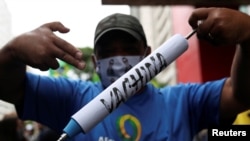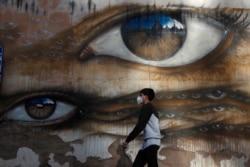Just hours after news of a breakthrough in the effort to develop a safe and effective COVID-19 vaccine, Brazil has halted late-stage clinical trials of another potential vaccine.
The country’s health regulator Anvisa announced Monday that it was pausing tests of CoronaVac, developed by Chinese pharmaceutical company Sinovac, after an “adverse, serious event” with a volunteer participant. The event occurred on October 29, but the statement did not go into any further details.
The clinical trials in Brazil are being conducted by Sao Paulo-based research institute Butantan. Dimas Covas, the head of the state-run institute, told a local television station that a volunteer had died, but the death was ruled not due to the vaccine.
The Sinovac vaccine is the third to be put on hold after a volunteer became ill after being inoculated. U.S. pharmaceutical giant Johnson & Johnson put a hold on its late-stage clinical trials of its COVID-19 vaccine last month, while another U.S.-based drugmaker, AstraZeneca, halted its late-stage trial of a vaccine developed with the University of Oxford in September after a volunteer in Britain was diagnosed with transverse myelitis, an inflammatory syndrome that affects the spinal cord and is often sparked by viral infections.
It is not uncommon for clinical trials to be suspended if a volunteer falls ill so that organizers can determine whether the illness is due to the vaccine. But Brazilian President Jair Bolsonaro, who has often expressed mistrust of China, has openly doubted the effectiveness of the Sinovac vaccine, and has insisted that his government will not purchase the drug.
New COVID drug
Better news came earlier in the day from the U.S. Food and Drug Administration, which approved emergency use of the first antibody drug for people with mild to moderate cases of COVID-19.
The drug, known as bamlanivimab, was jointly developed by U.S.-based drugmaker Eli Lilly and Canadian-based biotech firm AbCellera. It is part of a class of treatments known as monoclonal antibodies, which are made to act as immune cells that scientists hope can fight off the virus. The antibody therapy was similar to one given to U.S. President Donald Trump after he tested positive for COVID-19 early last month.
The FDA has approved the drug for people 12 years old and older who are at risk of developing a serious form of COVID-19.
A clinical trial of the drug conducted by the National Institute of Allergy and Infectious Diseases was called off late last month after researchers found it was not effective at treating patients hospitalized with an advanced stage of the disease.
News of the approval of Eli Lilly’s antibody drug, coupled with Pfizer’s announcement that its experimental vaccine was 90% effective in preventing the virus in participants without evidence of prior infection, came on the same day as the United States surpassed 10 million total COVID-19 cases, including more than 100,000 new cases on Monday, with the New York Times reporting more than 130,000 cases.
The United States has added an average of more than 100,000 new cases per day over the past week, double its daily infections from a month ago. About 900 people are dying each day.
Midwestern states are being hit the hardest, with hospitalization rates in the region reaching record highs. The COVID-19 Tracking Project said more than 59,000 people were hospitalized nationwide on Monday.
COVID elsewhere
COVID-19 infections have spiked in other parts of the world, including in Europe, where some governments have instituted lockdown measures to slow the spread of the virus. Globally the number of confirmed cases is more than 50 million, with 1.2 million deaths and 33 million people recovered.
The situation is worsening in Italy, where five more regions have been placed in the government’s so-called “orange” zone of its new three-tiered system that imposes various degrees of restrictions.
The system splits Italy’s 20 regions into three colored zones - red, orange and yellow - with red indicating the most restricted areas and yellow the least restricted.
Abruzzo, Umbria, Tuscany, Liguria and Basilicata will join the southern regions of Puglia and Sicily in the orange, or medium, zone; under this zone, residents can move freely within their towns or cities, but cannot leave them, while bars and restaurants are limited to delivery and takeout service.
The northern province of Bolzano has been placed in the red zone, joining its sister regions of Lombardy, Piedmont, Valle d’Aosta, and the southern region of Calabria. Residents in these zones will not be allowed to leave their homes except for work or medical reasons.
All of Italy is under a 10 p.m.-to-5 a.m. curfew, while museums and shopping centers are closed on the weekend and high school classes switch from in-person to online.
Italy has 960,373 confirmed novel coronavirus cases, including 41,750 deaths, according to the Johns Hopkins Coronavirus Resource Center.










